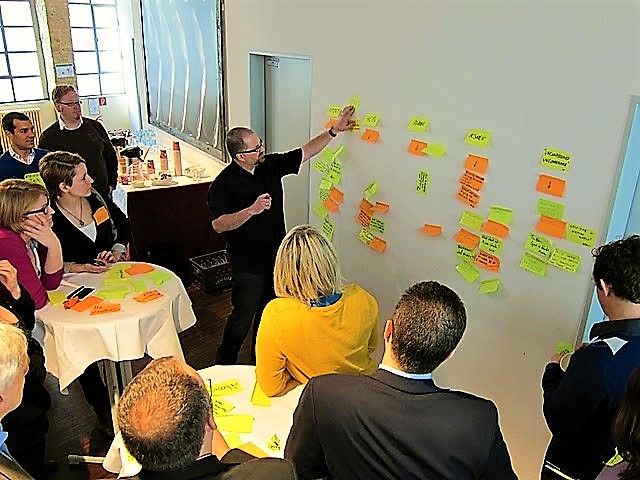Executive Summary
The nominal group technique is used for a meeting with a small group of participants with the aim of producing and prioritising ideas about a particular topic. The technique supports planners and managers in engaging selected stakeholders to participate in a productive dialogue and to generate ideas before decisions are made or programs are developed. Furthermore, the nominal group technique is used to support consensus planning for the purpose of prioritising issues. In addition, this technique can be applied when you want to assure all members participate freely without negative influence from other participants.
What Is the Nominal Group Technique?
(Adapted from CLARK & STEIN 2004; RECREATION AND TOURISM RESEARCH INSTITUTE 2007; WBI EVALUATION GROUP 2007)
In 1968, the nominal group technique was developed as a ‘participation technique for social planning’ by Andre Delbecq and Andrew Van de Ven. Nowadays, it is used for primary data collection, program planning, evaluation, and exploratory research.
Similar to focus groups, this method is used for a meeting with a small group of participants (usually 9 to 12) with the aim of generating and prioritising ideas about a particular topic. However, the discussion in a nominal group is more structured than within focus groups, with the final outcome of a meeting producing a list of participants’ preferred alternatives to the issue presented. The tool is useful for idea generation and is often applied during exploratory stages of research. The technique supports planners and managers engage selected stakeholders in productive dialogue and generate ideas before decisions are made or programmes are developed.
This dynamic group decision‐making process is flexible enough that you may apply it multiple times at different steps within your needs assessment (see also participatory decision making). Furthermore, you can use this tool whenever a group of participants with multiple perspectives has to make a difficult decision.
How Is the Nominal Group Technique Conducted?
(Adapted from CLARK & STEIN 2004)
Step 1: Presentation of the Issue
The facilitator first describes how the meeting should be conducted and what is expected of the participants. Then, the topic of the discussion is presented. It is advisable to provide participants beforehand with detailed information on the meeting, so that they are well prepared. The facilitator has to make sure that the participants do clearly understand the issue and its question before moving on to the second step.
Step 2: Individual Brainstorming
Participants are given five minutes to individually and silently write down all of their ideas for the question on the notepaper which is provided. Participants are encouraged to be creative with their answers and not be restricted by budgetary constraints or current regulations of the site. The facilitator should remind the participants that this is a time for individual brainstorming and the participants have to be instructed that everyone should remain quiet the entire time.
Step 3: Documentation
After the brainstorming session, each participant is asked to explain one of the opportunities on his or her list. As the participant read his or her opportunity, the note-taker writes down the opportunity exactly as stated. Statements are recorded and assigned an individual number by the note-taker on flipchart paper in front of the room. During this step, extensive discussion of an idea is discouraged unless further clarification is necessary. Participants are encouraged to build upon each other’s ideas and write down any new ideas as the meeting progressed. The facilitator goes around the room in a round-robin style until all participants’ lists are exhausted.
Step 4: Consolidation and Review of Ideas
To help clarify and reduce any duplication of ideas, participants are asked to look over all the statements listed on the flip chart paper posted around the room. In a serialised fashion, each idea is discussed. If all participants agree to combine or delete any opportunities, the note-taker combines or crosses out those items.
Step 5: Ranking
Participants are directed to look at the flipchart papers posted around the room and asked to select and score their most preferred opportunities (e.g. with coloured stickers, or marks). After individually listing and ranking their top opportunities, each participant then marks his or her scores next to the numbered opportunity on the flipchart. Instead of marking scores directly onto the flipchart, a number of different methods may be used, including filling out worksheets or coloured cards with the statement and importance score identified. Similarly, the exact number of preferred ideas participants select is flexible and depends upon several factors, including the amount of ideas generated and the level of consensus needed. For example, if participants only generate 15 ideas, then the top five is probably sufficient. (For more information on ranking techniques see also preference ranking).
Step 6: Compilation of Results

To identify each group’s most preferred opportunities for each meeting, the individual scores participants assigned to each statement are summed up, and then statements are sorted from highest to lowest. In other words, the group’s most preferred recreation opportunity receives the highest score, and their least preferred opportunity receives the lowest score.
The nominal group technique is used to support consensus planning regarding sanitation and water issues for the purpose of prioritising issues. In addition, this technique can be applied when you want to produce a lot of ideas to and want to assure all members participate freely without negative influence from other participants. The nominal group technique is often conducted when you want to identify priorities or select a few alternatives for further examination. Furthermore, it can be used when the team is stuck on an issue, for example when they disagree about something or when the group prefers a structured style of working together (adapted from WBI EVALUATION GROUP 2007; THE UNIVERSITY OF KENTUCKY n.y.).
Gaining Consensus Among Stakeholders Through the Nominal Group Technique
This document explains how and when to use the nominal group technique and describes the advantages and disadvantage.
CDC (2006): Gaining Consensus Among Stakeholders Through the Nominal Group Technique. Evaluation Research Team URL [Accessed: 17.08.2010]Applying the Nominal Group Technique to Recreation Planning on Public Natural Areas
The purpose of this paper is to describe and demonstrate the value of the nominal group technique as a means to effectively and efficiently incorporate stakeholders into a public land management agency’s recreation planning process.
CLARK, J. K. ; STEIN, T. V. (2004): Applying the Nominal Group Technique to Recreation Planning on Public Natural Areas. In: Journal of Park and Recreation Administration: Volume 22 , 1-22.Nominal Group Technique: A Users' Guide
Nominal Group Technique. What is a Nominal Group Technique? A Guide to Research Tools
This document explains how and when to use nominal group technique and describes the advantages and disadvantage. Furthermore, this paper contains an example of using this technique.
RECREATION AND TOURISM RESEARCH INSTITUTE (2007): Nominal Group Technique. What is a Nominal Group Technique? A Guide to Research Tools. Nanaimo: Recreation and Tourism Research Institute. [Accessed: 17.08.2010] PDFNominal Group Technique
This document describes the advantages and disadvantages of using nominal group technique and explains the process of applying this tool.
WBI EVALUATION GROUP (2007): Nominal Group Technique. Washington DC: World Bank URL [Accessed: 07.07.2019]Nominal Group Technique Discussion
Handout Nominal Group Technique
Applying the Nominal Group Technique to Recreation Planning on Public Natural Areas
The purpose of this paper is to describe and demonstrate the value of the nominal group technique as a means to effectively and efficiently incorporate stakeholders into a public land management agency’s recreation planning process.
CLARK, J. K. ; STEIN, T. V. (2004): Applying the Nominal Group Technique to Recreation Planning on Public Natural Areas. In: Journal of Park and Recreation Administration: Volume 22 , 1-22.Nominal Group Technique. What is a Nominal Group Technique? A Guide to Research Tools
This document explains how and when to use nominal group technique and describes the advantages and disadvantage. Furthermore, this paper contains an example of using this technique.
RECREATION AND TOURISM RESEARCH INSTITUTE (2007): Nominal Group Technique. What is a Nominal Group Technique? A Guide to Research Tools. Nanaimo: Recreation and Tourism Research Institute. [Accessed: 17.08.2010] PDFNominal Group Technique
This document describes the advantages and disadvantages of using nominal group technique and explains the process of applying this tool.
WBI EVALUATION GROUP (2007): Nominal Group Technique. Washington DC: World Bank URL [Accessed: 07.07.2019]Gaining Consensus Among Stakeholders Through the Nominal Group Technique
This document explains how and when to use the nominal group technique and describes the advantages and disadvantage.
CDC (2006): Gaining Consensus Among Stakeholders Through the Nominal Group Technique. Evaluation Research Team URL [Accessed: 17.08.2010]Nominal Group Technique
This document describes the advantages and disadvantages of using nominal group technique and explains the process of applying this tool.
WBI EVALUATION GROUP (2007): Nominal Group Technique. Washington DC: World Bank URL [Accessed: 07.07.2019]

